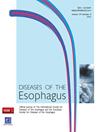307. A REVIEW OF 31 SUPERFICIAL ESOPHAGEAL CANCER CASES WITHOUT HISTORY OF HABITUAL DRINKING OR SMOKING OBSERVED IN OUR HOSPITAL
IF 2.3
3区 医学
Q3 GASTROENTEROLOGY & HEPATOLOGY
引用次数: 0
Abstract
In Japan, alcohol consumption, smoking, and genetic an aldehyde dehydrogenase 2 polymorphisms are risk factors for most esophageal squamous cell carcinomas(ESCC). However, only a limited number of cases have been observed without these risk factors in daily practice. This study aimed to evaluate the endoscopic findings of 31 lesions in 29 patients with ESCC who underwent endoscopic submucosal dissection (ESD) at our hospital without a history of habitual alcohol consumption or smoking (hereafter referred to as ‘risk factors’). Patients and Methods: We retrospectively examined the endoscopic findings, final diagnoses, and patient and lesion backgrounds of 31 lesions from 29 patients of ESCC without risk factors who underwent ESD from January 2017 to December 2022 at our hospital. A total of 27 women and two men, median age 72 (44–87) years, were included; 10 patients were on proton pump inhibitors, 12 patients had a history of cancer, and 12 patients had a family history of cancer in the first degree. Additionally, three patients had multiple heterochronic lesions, one patient had a speckled esophagus, and two patients had grade B gastroesophageal reflux disease according to the revised Los Angeles classification. Occupied site; Ut/Mt/Lt = 4/24/3, circumferential; anterior/posterior/left/right wall = 0/16/10/5, macroscopic type; 0-IIa/0-IIb/0-IIc/mixed type = 4/10/15/2, median lesion length 17(5–45) mm, wall depth; EP/LPM/MM/SM1 = 11/18/1/1/1, all vascular invasions were negative. A total of 22 lesions had white-tone mucosa on their surface, suggesting superficial keratinization or hyperkeratinization. The lesions were diverse in shape. Additionally, seven lesions were observed which tended to run longitudinally with long axial lengths, all located on the posterior wall of Mt, and white adherent material was observed in six lesions. Iodine staining was performed in 30 lesions, all of which were unstained, and six of them had indistinct borders with inflammatory changes in the background. A total of three patients had synchronous/heterochronic multiple esophageal cancers. The white adherents running longitudinally in the posterior wall of the Mt and its white tone in patients with no risk factors suggest the possibility of previously unrecognized lesions and the need for close endoscopic examination, along with iodine staining and biopsy.307.我院31例无习惯性饮酒或吸烟史的浅表性食管癌病例回顾性分析
在日本,饮酒、吸烟和遗传性乙醛脱氢酶2多态性是大多数食管鳞状细胞癌(ESCC)的危险因素。然而,在日常实践中,只有少数病例没有这些风险因素。本研究旨在评估29名ESCC患者的31个病变的内镜检查结果,这些患者在我院接受了内镜下黏膜下剥离术(ESD),没有习惯性饮酒或吸烟史(以下简称“风险因素”)。患者和方法:我们回顾性检查了2017年1月至2022年12月在我院接受ESD治疗的29名无危险因素ESCC患者的31个病变的内镜检查结果、最终诊断以及患者和病变背景。共有27名女性和两名男性,中位年龄72岁(44-87岁);10例患者服用质子泵抑制剂,12例患者有癌症病史,12例有一级癌症家族史。此外,根据修订后的洛杉矶分类,三名患者有多个异时病变,一名患者有斑点食道,两名患者有B级胃食管反流病。占用场地;Ut/Mt/Lt = 4/24/3,周向;前/后/左/右壁 = 0/16/10/5,宏观型;0-IIa/0-IIb/0-IIc/混合型 = 4/10/15/2,中位病变长度17(5-45)mm,壁深;EP/LPM/MM/SM1 = 11/18/1/1/1,所有血管侵犯均为阴性。共有22个病变表面有白色粘膜,提示浅表角化或过度角化。病变形态多样。此外,观察到7个病变,这些病变倾向于纵向延伸,轴向长度较长,均位于Mt的后壁上,在6个病变中观察到白色粘附物质。对30个病灶进行了碘染色,所有病灶均未染色,其中6个病灶边界模糊,背景有炎症变化。共有三名患者患有同步/异时性多发性食管癌。在没有危险因素的患者中,Mt后壁纵向排列的白色粘附物及其白色色调表明可能存在以前未识别的病变,需要进行密切的内镜检查以及碘染色和活检。
本文章由计算机程序翻译,如有差异,请以英文原文为准。
求助全文
约1分钟内获得全文
求助全文
来源期刊

Diseases of the Esophagus
医学-胃肠肝病学
CiteScore
5.30
自引率
7.70%
发文量
568
审稿时长
6 months
期刊介绍:
Diseases of the Esophagus covers all aspects of the esophagus - etiology, investigation and diagnosis, and both medical and surgical treatment.
 求助内容:
求助内容: 应助结果提醒方式:
应助结果提醒方式:


